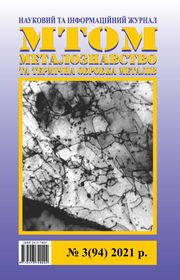INVESTIGATION OF THE CAUSES OF UNSATISFACTORY RESULTS OF ULTRASOUND CONTROL OF EXPERIMENTAL FORGES FROM AUSTENITE HIGH-ALLOY STEEL
DOI:
https://doi.org/10.30838/J.PMHTM.2413.010721.26.779Abstract
The purpose of the work is to establish the main causes of defects by ultrasonic testing (UST) of experimental forgings made of high-alloyed austenitic steel 08Kh18N10T on the basis of comprehensive comparative studies of samples of defective and suitable forgings. Techniques. Chemical analysis of forgings was performed on a high-sensitivity spectrometer "SPECTROMAX" company "SPECTRO", Germany; studies of macro- and microstructure (liquation heterogeneity, grain boundary structure, non-metallic inclusions, excess phases, etc.) were carried by the methods: metallographic and electron microscopic with micro-X-ray spectral analysis; tests of forgings for durability against intergranular corrosion (IGC) were carried out by the methods of AMU, GOST 6032. Results. It was established that experimental forgings rejected by UZK, in contrast to suitable forgings, were characterized by: the presence of areas of liquation inhomogeneity of steel, including high content of δ-ferrite; local defects of the macrostructure in the form of flocs; areas with anomalous multi-grained microstructure with a grain size of –2 to
8 points according to GOST 5639; release of chromium carbides at the boundaries of austenitic grains; susceptibility to intergranular corrosion (ICC). All forgings contained non-metallic inclusions within the permissible limits according to GOST 1778, as well as titanium carbides. Scientific novelty. For the first time on the basis of complex researches it is proved that the main reason of unsatisfactory results of UZK of experimental forgings from high-alloyed austenitic steel, is the anomalous multigrain structure connected with the unstable temperature-deformation mode of forging of ingots. Practical significance. Recommendations for improving the structure and improving the quality characteristics of industrial forgings made of high-alloy austenitic steels in terms of industrial production have been developed.

Downloads
Published
Issue
Section
License
Authors that are published in this journal agree to follow the conditions:
Authors reserve the right to the authorship of his work and cede the right to the journal of first publication of this work on conditions of the license under the Creative Commons Attribution License, which allows others to distribute it freely with the obligatory reference to the author of the original work and the first publication of the work in this journal.
